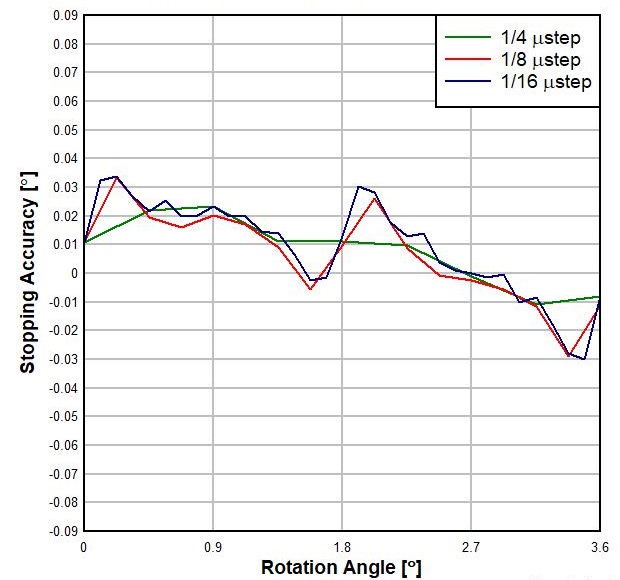SLOA293A September 2020 – October 2021 DRV8424 , DRV8426 , DRV8428 , DRV8434 , DRV8434A , DRV8434S , DRV8436 , DRV8436E , DRV8889-Q1
2.2.3 Microstepping Levels
Operating a stepper motor in full-step mode causes the motor to jump by one step angle (1.8° mechanical rotation in most cases), resulting in overshoot, torque ripple, and vibrations. As a result, most stepper drivers today incorporate microstepping, which splits the full-step into smaller equal segments, and therefore provides capability of smooth stepping and accurate positioning.
One effect of microstepping is to reduce the vibration of the stepper motor, by smoothening the motion of the motor to its intended location. For example, in a printer, any vibration will result in poor printing quality. By using microstepping, vibration can be significantly reduced and consequently, printing quality can be improved.
The DRV84xx and DRV88x9-Q1 family of stepper drivers feature microstepping up to 1/256 levels, leading to easy adaptability to any application that requires high accuracy and smooth stepper movement. The following plot shows similar accuracy with 1/4, 1/8 and 1/16 microstepping for the DRV8424.
 Figure 2-4 Stopping Accuracy at Different Microstepping.
Figure 2-4 Stopping Accuracy at Different Microstepping. However, as the number of microsteps per full step is increased, the incremental torque per microstep reduces significantly. The expression for incremental torque for a single microstep is:

Where TINC is the incremental torque per microstep, THFS is the holding torque in full step and N is the number of microsteps per full step. Table 2-1 shows the variation of incremental torque:
Microsteps per Full Step | % Holding Torque per Microstep |
|---|---|
1 | 100% |
2 | 70.7% |
4 | 38.3% |
8 | 19.5% |
16 | 9.8% |
32 | 4.9% |
64 | 2.5% |
128 | 1.2% |
256 | 0.6% |
Therefore, a motor running in full steps will have 100% of its rated holding torque. Moving to 16 microsteps/full steps drops this to approximately 10%, and 1/128 microstepping drops incremental torque to approximately 1% of holding torque. If the incremental torque is less than the sum of the load torque, the friction torque (due to bearings) of the motor, and detent torque, multiple microsteps will have to be realized until the motor shaft can actually turn. If reversing direction is desired, a significant number of microsteps may be needed before movement occurs.
Therefore, higher microstepping will result in better positional accuracy only if the incremental torque is more than the torque needed to move the load. Many motor manufacturers have recommendations on the highest level of microstepping that can be used for that motor.